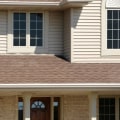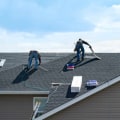The roofing materials that last the most are concrete, clay or slate tiles. These materials significantly outperform other natural products, such as wooden beams or any material manufactured for roofing, including asphalt shingles and metal roofs. Concrete, clay and slate tiles have an average lifespan of 100 years or more, making them the most durable roofing materials available. However, they are also some of the most expensive.
Slate roofs are often referred to as “forever roofs” due to their long-lasting nature. Many houses in Europe have slate roofs or clay tiles because they were easy to manufacture years ago and have been proven to stand the test of time (and the elements). It's important to remember that materials aren't everything when it comes to roofing. In addition to choosing the right type, it's important to choose a brand of roofing material that is known for being of high quality.
For example, while wooden shingles are generally estimated to last between 15 and 20 years, opting for low-quality tiles to save a few dollars is likely to shorten their lifespan by a few years. Choosing poor quality materials, no matter the type, will always result in a shorter lifespan than if you had chosen a higher quality material. The most durable roofs are generally made of materials that decay very slowly, such as concrete, clay, and slate. Metal roofs are also very durable.
Asphalt tile and wooden tile roofs tend to have the shortest lifespan. Installing asphalt shingles is a low-cost option that is very popular in the slanted roof market in New York and the East Coast. In the case of asphalt shingles, it prevents the tiles from adhering directly to the plywood roof, making them easier to remove when it's time to replace the roof. These are the general patterns for buying or deciding on a roof for your home, and the factors mentioned above play an important role in the life expectancy of your roof.
In addition to their long lifespan and ease of use, builders have always used copper roofs for their beauty, both in their raw and eroded state. So, if your roof materials are clay, slate or concrete, the choice of colors is limited, even though the construction cost is still high. There are numerous factors that can affect the material of your roof, such as weather conditions, the quality of the building's construction, architectural design, roof maintenance and, of course, the quality of the material installed. Similarly, an asphalt shingle roof should be inspected after a severe storm or other severe weather and repaired as needed.
Ultimately, a home with a sturdy roof cover has good insulation and a solid foundation to withstand unwanted environmental hazards, such as heavy hailstorms, rain, snow, etc. Based on this list of materials and their respective lifespans, you can see that there is a wide range of life expectancy in all roofing materials. Asphalt tile roofs can be relatively affordable to repair and can often be covered with insurance for damage caused by hail or wind. Not every roof requires an undercoat but it's important to consider this as it can be the Achilles' heel of even the most durable roof. Therefore, choosing a roofing material that is aesthetically pleasing and blends well with your coating should be an important deciding factor.
Some require less maintenance than others and that can be a great option for those who don't want to do the work of maintaining a roof.











